Home / Alkene Stability
Alkene Reactions
Alkene Stability
Last updated: March 20th, 2024 |
Alkene Stability (And Instability)
What factors affect alkene stability? If you’ve studied elimination reactions, no doubt you’ve learned about Zaitsev’s Rule – about how elimination reactions generally favor the “more substituted” alkene.
In this post we explore how increasing substitution at carbon increases the stability of alkenes, as well as the effects of conjugation and strain.
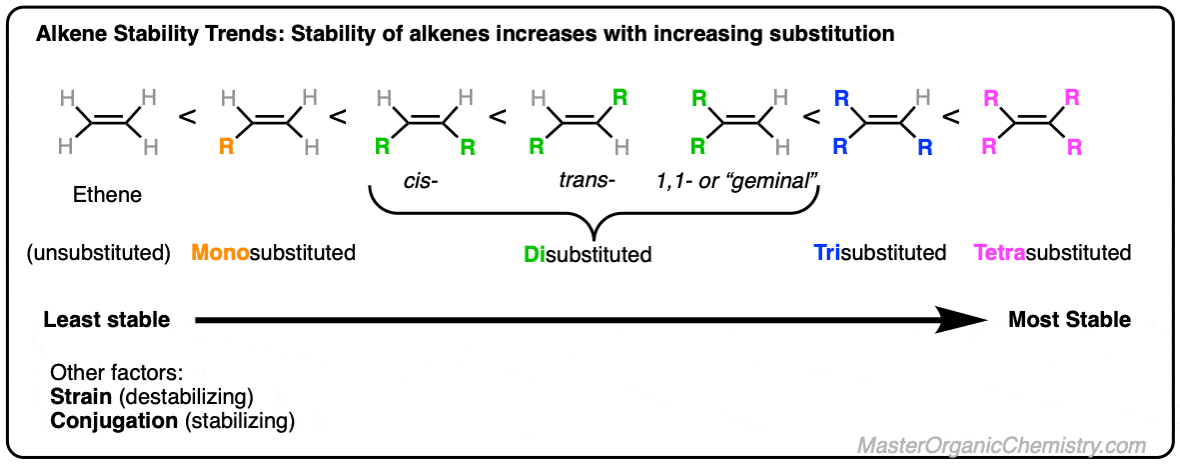
Table of Contents
- Heat Of Hydrogenation As A Measure Of Alkene Stability
- Stability of Alkenes Increases With Increasing Substitution
- Heats Of Hydrogenation For Some Monosubstituted Alkenes
- The Relative Stability of cis- and trans- Alkenes
- Alkenes Stabilized By Conjugation: Resonance Energy
- Alkene Stability: Summary
- Notes
- Bonus Topic #1: Why Is Alkyl Substitution Stabilizing?
- Bonus Topic #2: trans-Cycloalkenes
- Quiz Yourself!
- (Advanced) References and Further Reading
1. Heat Of Hydrogenation As A Measure Of Alkene Stability
We might not spend as much discussing thermodynamics in here organic chemistry as you did in general chemistry, but that doesn’t mean the concepts have just gone away!
One area where we’ve previously seen the usefulness of thermodynamic data is the use of heat of combustion data to quantify ring strain. [See: Cycloalkanes – How To Calculate Ring Strain]. The heat of combustion for cyclopropane works out to about 166 kcal/mol per CH2 compared to the heat of combustion for unstrained cyclohexane [157 kcal/mol per CH2]. That “extra” heat of combustion seen in cyclopropane is attributed to the instability arising from the strain of bent C-C bonds far away from their ideal angle of 109.5°. That’s angle strain.
Another area of organic chemistry where thermodynamic studies are useful in the stability of alkenes.
Back in 1935, Prof. Kiasatakowsky and co-workers at Harvard published a method for measuring the heat of hydrogenation of ethylene (aka “ethene”) as it was passed over a finely divided metal catalyst containing adsorbed hydrogen. [Note 1] Because hydrogenating a molecule is considerably more gentle than, say, BURNING it, the method tends to be more sensitive for determining subtle differences in enthalpies.
In a hydrogenation reaction, a C-C bond is broken, and two new C-H bonds are formed.
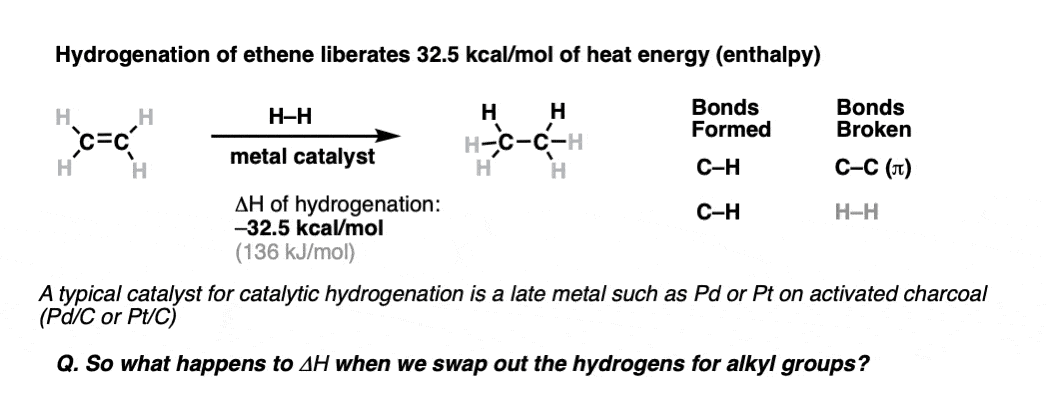
It was found that hydrogenation of ethylene released 32.5 kcal/mol (136 kJ/mol) of heat. [Note 2]
Once the heat of hydrogenation of ethene was obtained, the next logical step was to measure the heat of formation for a huge variety of other alkenes, and to see what patterns emerged from the data.
So what happens to the heat of hydrogenation when alkyl groups are added to the alkene?
2. Stability of Alkenes Increases With Increasing Substitution
Well, as you might imagine from someone who had invented a new technique, Kiastakowsky went to town on this, investigating the heat of hydrogenation of a huge variety of alkenes. [Note 3] In the following decades, even more data has been accumulated, which is easily obtainable (with references) from the NIST Chemistry Web Book.
For our purposes, there are six substitution patterns on an alkene (seven if you count ethene).

The most notable trend that was found is that the heat of hydrogenation decreases as C-H bonds are replaced with C-C bonds.
So what does that mean?
Since the same bonds are formed and broken in every hydrogenation reaction, the heat of hydrogenation is measuring the stability of each type of alkene.
This means that the lower the heat of hydrogenation, the greater the stability of the alkene.
The way to visualize “stability” here is to compare it to potential energy, much like a ball becomes more “unstable” with increasing height.
So what we’re really saying here is that alkene stability increases with increasing substitution of hydrogen for carbon.
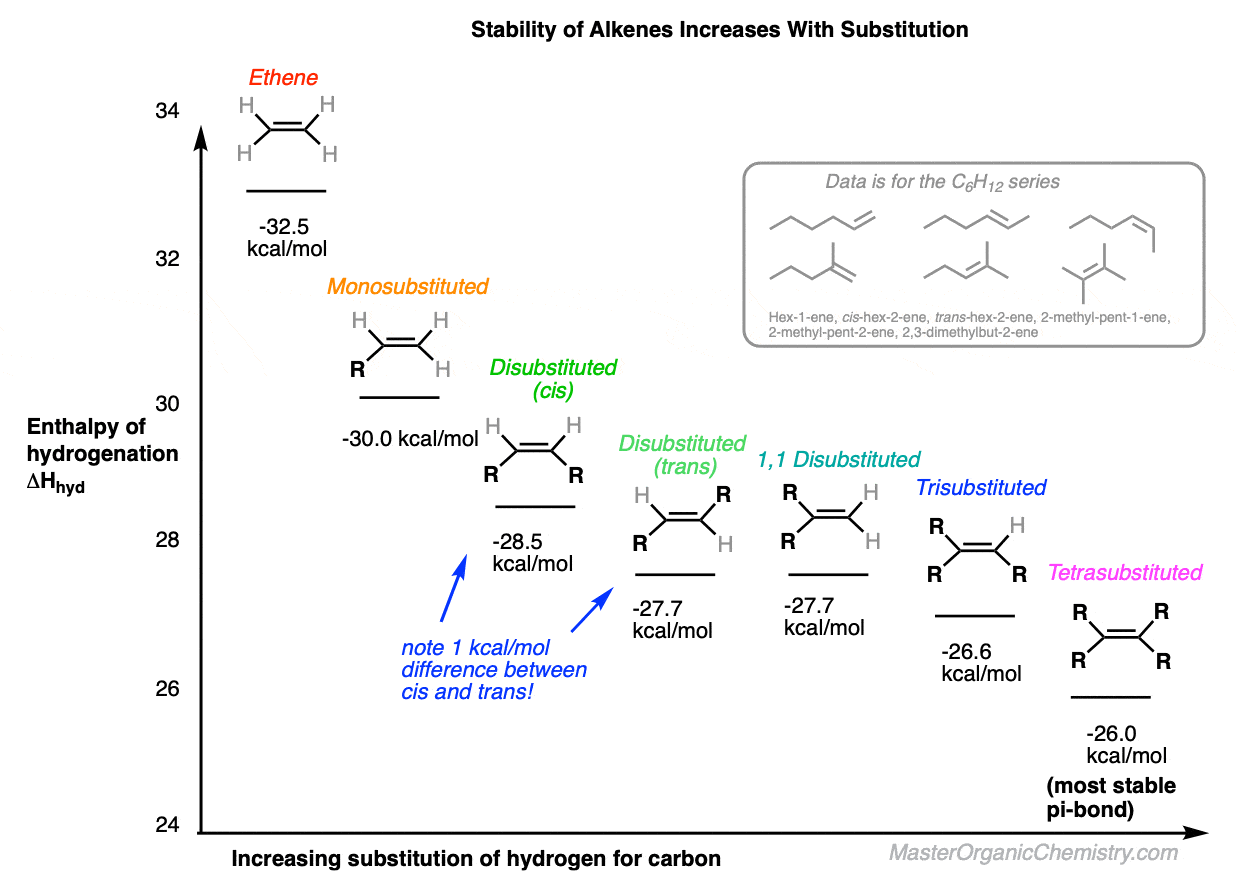
[The image above uses heat of hydrogenation data for the series hex-1-ene, trans-hex-2-ene, cis hex-2-ene, 2-methylpent-1-ene, 2-methyl-pent-2-ene, and 2,3-dimethylbutene, which all share the molecular formula C6H12. ]
OK, you might ask. So, why does this happen?
The short answer is that substitution of alkyl groups on the alkene allows for donation of electron density between (full) C-C sigma orbitals and the (empty) C-C pi star orbital. It’s often not addressed in introductory courses, so we’ll push the explanation down to this footnote. [Bonus topic one]
3. Heats Of Hydrogenation For Some Monosubstituted Alkenes
Just for fun, let’s look at a series of mono-substituted alkenes. Nothing weird here, we’ll just go from propene up to hex-1-ene.
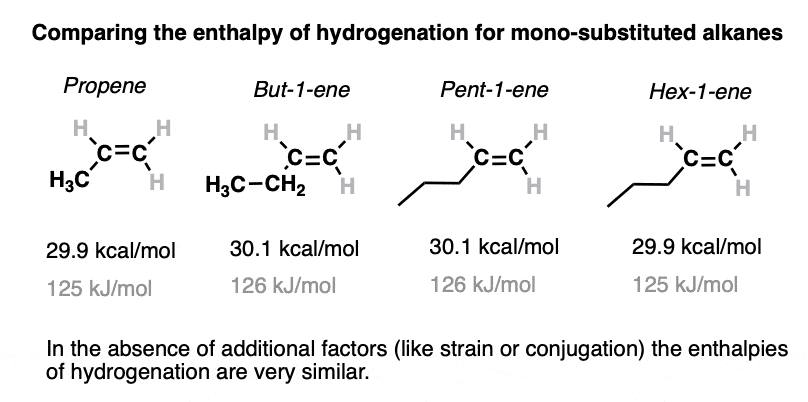
Note that the heat of hydrogenation is quite consistent for a series of linear, non-branched, monosubstituted alkenes.
4. The Relative Stability of cis- and trans- Alkenes
So what about disubstituted alkenes? There are three types (cis, trans, and 1,1-disubstituted) but let’s just concern ourselves with cis and trans here.
We all know by now that cis and trans alkenes should differ a little bit in stability because in a cis alkene the groups are held closer together (more strain!) and in a trans-alkene they are further apart. [For a good time, amaze your instructor and call it by its proper name: 1,2-strain]
Heat of hydrogenation data actually allows us to quantify the difference in stability between cis and trans alkenes.
For instance, compare cis– and trans– but-2-ene, or cis- and trans hex-2-ene. The difference in stability is about 1 kcal/mol, rounding up generously.
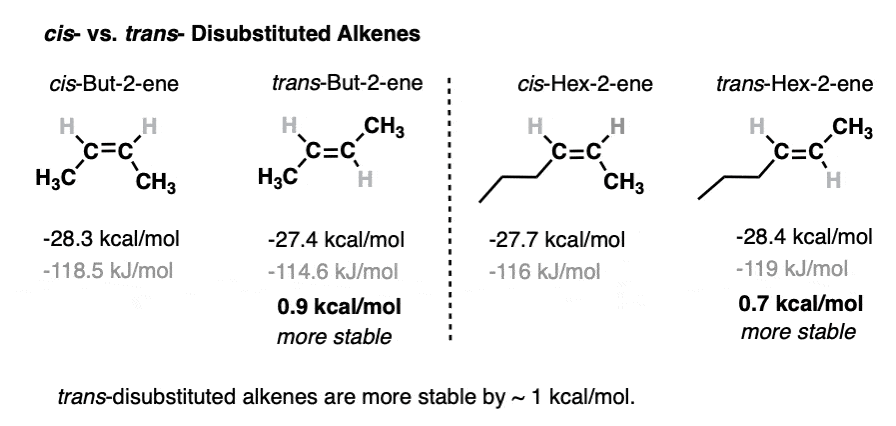
While a difference of 1 kcal/mol might not seem like a lot, it isn’t *that* small – for an equilibrium at 25 °C, a difference of 1 kcal/mol will give you about an 80:20 ratio of products. [Note 4]
For a really good time you can pick something crazy like the cis– and trans- di t-butyl ethylene. [not the correct IUPAC name, but definitely more vivid than cis- and trans- 2,2,5,5-tetramethylhex-3-ene].
Here the trans is more stable than the cis by about 10 kcal/mol.
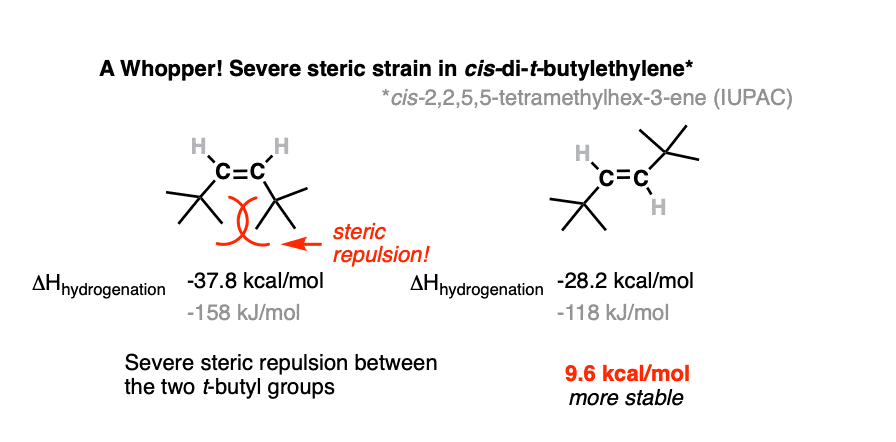
That’s a lot of strain.
5. Alkenes Stabilized By Conjugation: Resonance Energy
The stability of alkenes is also affected by conjugation. This is a really a topic for another chapter [specifically, see Conjugation and Resonance] where we talk about pi systems, but the bottom line is that the p-orbitals in adjacent pi-bonds can clump together forming larger “pi-systems”, which provides more “room” for electrons to roam, lowering their energy. [Note 5]
Heat of hydrogenation numbers allow us to quantify the effect of resonance stabilization. How so?
Take but-1-ene. As we saw above the heat of hydrogenation is about 30.1 kcal/mol.
Add a double bond, and you might expect the heat of hydrogenation to double as well. But it doesn’t! It’s actually a little bit less. [56.6 kcal/mol] . The difference (that extra 3.6 kcal/mol of additional stabilization) is called “resonance energy“.
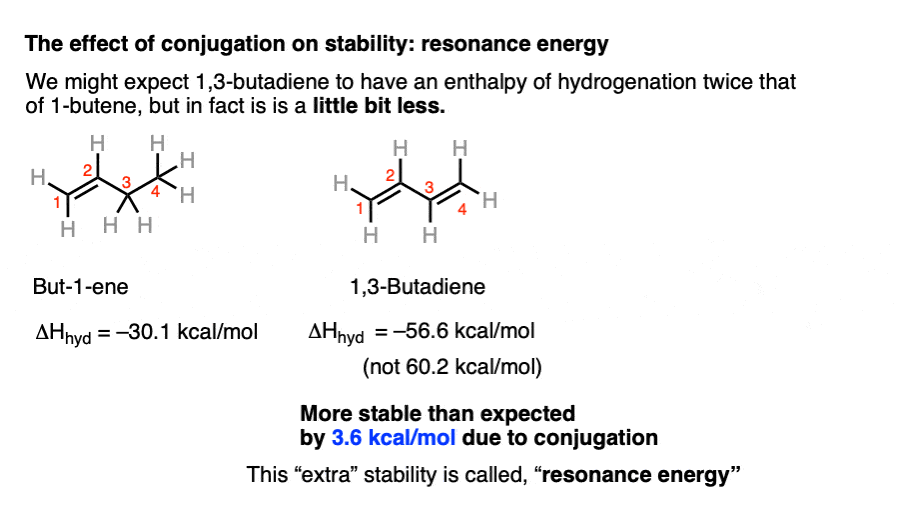
The most dramatic example of resonance energy is found in the example of “cyclohexatriene” , which has an extra stabilization energy of 36 kcal/mol. That’s a sure sign that something highly unusual is going on with this molecule, which is better known as “benzene”. That “highly unusual” property is called aromaticity and it warrants its own chapter. [See: Introduction to Aromaticity]
6. Summary: Stability of Alkenes
Three key factors affect the stability of alkenes, and the influence of these factors can be measured through the enthalpy of hydrogenation.
- One important factor is the substitution pattern. As C-H bonds are replaced by C-C bonds, the stability of the alkene gradually increases in the order mono (least stable) < di < tri < tetrasubstituted (most stable).
- When hydrogenation liberates more energy than expected given the substitution pattern, that’s likely a sign of strain. This is exemplified in the difference in enthalpy of hydrogenation between cis- and trans- alkenes, where the trans- alkene is more stable by about 1 kcal/mol.
- When hydrogenation liberates less energy than expected given the substitution pattern, that’s a sign that some extra factor is stabilizing the molecule. Among commonly encountered factors, conjugation ranks high. The difference in energy between the “expected” heat of hydrogenation and the measured heat of hydrogenation is called the resonance energy. The conjugation of one pi bond with an additional pi bond is “worth” about 2-3 kcal/mol.
The increasing stability of alkenes with increasing substitution not only comes up in Zaitsev’s Rule, but also later in the course when you study Thermodynamic and Kinetic Control.
Notes
Related Articles
- Elimination Reactions (2): The Zaitsev Rule
- Conjugation And Resonance In Organic Chemistry
- Alkene Addition Reactions: “Regioselectivity” and “Stereoselectivity” (Syn/Anti)
- Reactions of Enols – Acid-Catalyzed Aldol, Halogenation, and Mannich Reactions
- More On 1,2 and 1,4 Additions To Dienes
- Introduction To Aromaticity
- Stereoselective and Stereospecific Reactions
Note 1. It was a copper catalyst, after a lot of trial and error. The advantage of measuring the heat of hydrogenation over the heat of combustion is that it is a more sensitive technique for measuring small energies.
Note 2. This number was first measured in 1935, remeasured in 1951, and so far as I am aware, has not been updated. See the entry in the NIST Chembook for ethylene.
Note 3. Standard heats of hydrogenation have been pulled from the NIST Chembook.
Note 4. Actually 82:18 at 298 K. From delta G = -RT ln K, using delta G of 1000 cal, T = 298 K, R = 1.987 cal / mol•K .
Note 5. If you think of electrons as waves, a larger pi-system allows for longer wavelengths, and since energy is inversely proportional to wavelength, this means a lower overall energy of the electron.
And a big thank you to The Kraken for his steady hands in the stability GIF.
Appendix 1: Why Does Increasing Substitution Increase Stability?
So why does increasing substitution at the alkene increase its stability? This is not an easy question to answer to an introductory audience in a few sentences, and given the time constraints of a typical course the answer you will generally get from an instructor will range from “it’s complicated” to “hyperconjugation” to “orbital mixing”. Very rarely you might get an MO diagram.
The unifying principle here is that full orbitals – even those from single bonds – can donate into empty (even antibonding) orbitals, and that this interaction is stabilizing.
In ethene (below left) all of the C-H bonds are in the plane of the alkene, and none can overlap with the pi bond.
When a methyl group is added, say, in propene, one of the C-H bonds can now align with the pi-system of the alkene. The pair of electrons from the C-H bond can then donate into the empty pi* orbital.
This can be visualized through “no-bond resonance”, below right, where a “resonance” form is shown with a broken C-H bond and a new C-C pi bond. [The quotation marks are to differentiate it from our traditional view of resonance where only pi-bonds are allowed to form and break].
This mixing results in a stabilization of the molecule. . Although CH3 is in rapid rotation, at any given moment at least one of the C-H bonds will have the proper geometry to allow overlap with the pi system. 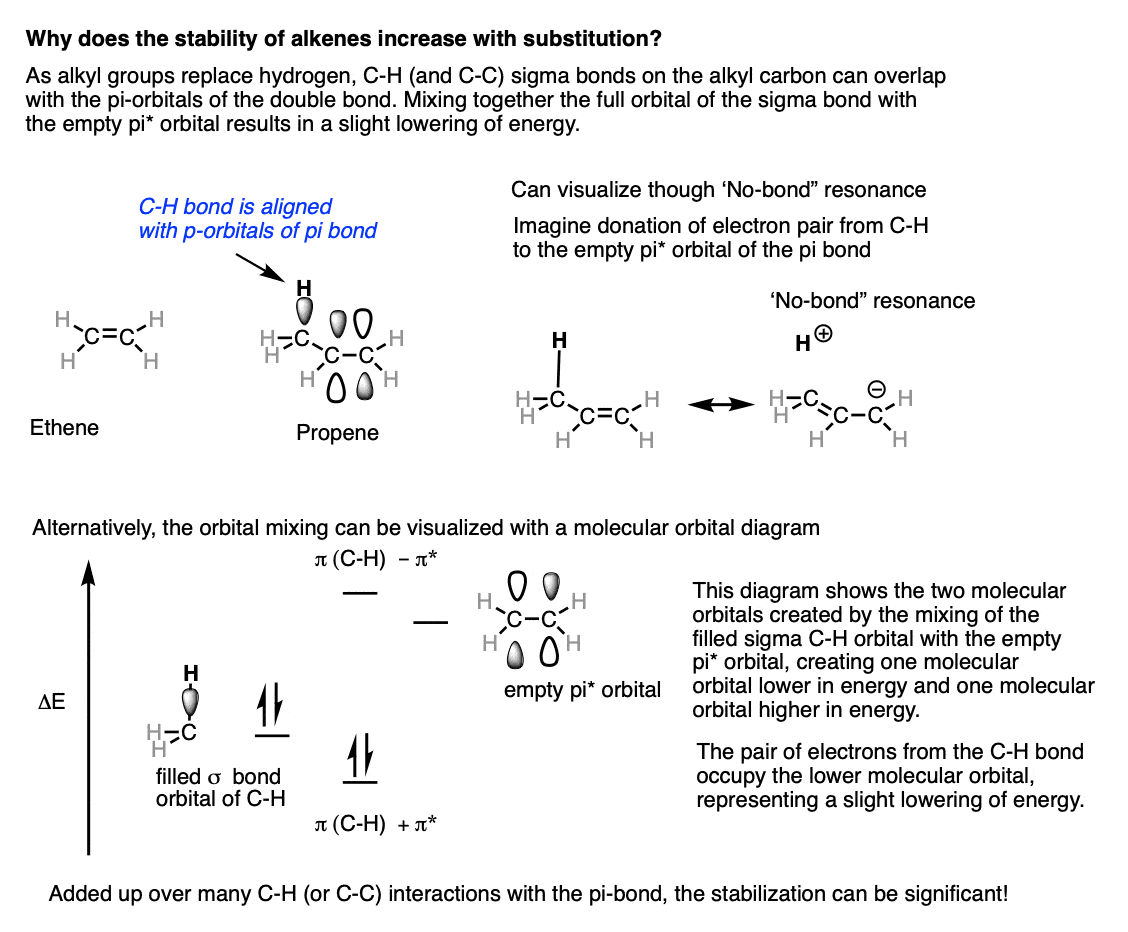
Predicted to slightly lengthen C-H and C-C pi and strengthen C-C sigma.
Appendix 2: trans-Cycloalkenes
99% of people reading this will never use this so it is going down in the footnotes.
In the vast majority of molecules you will encounter, the double bonds in rings are cis. Why? The most vivid answer is provided by trying to make them with a model kit.
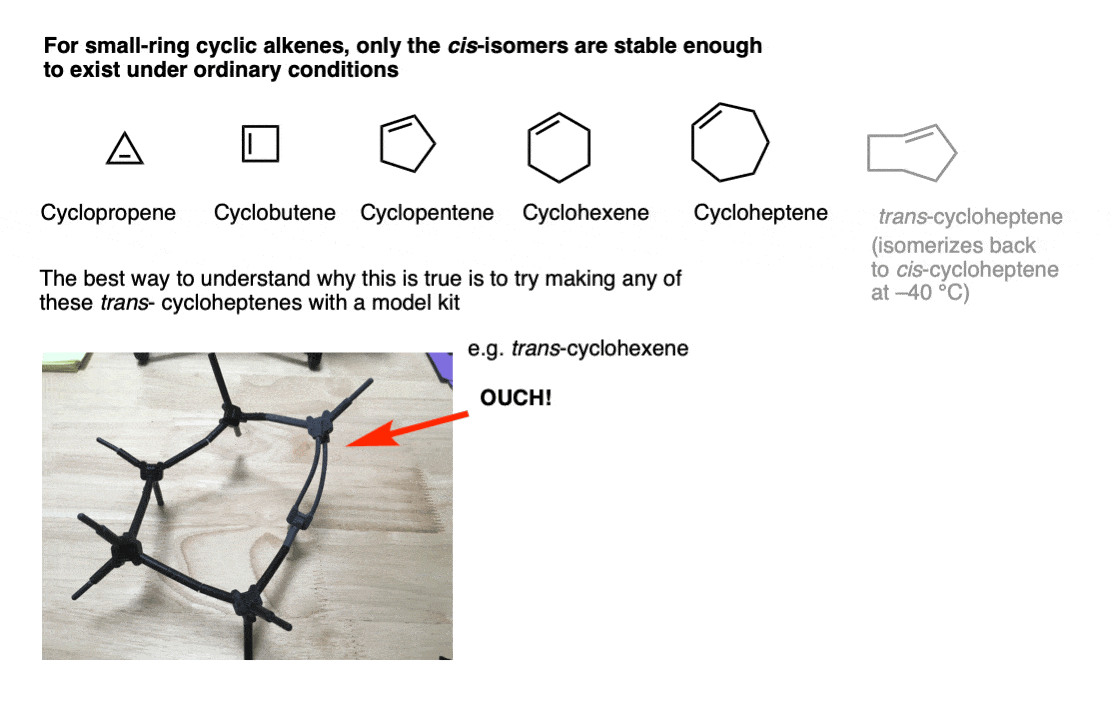
That is not a happy double bond.
However at a ring size of 7, a trans double bond becomes more than transiently stable (albeit very short lived at 0°), and at a ring size of 8 there’s enough floppiness in the ring such that its boiling point can be measured [143°C !] . Larger ring sizes than 8 can easily accommodate a trans double bond.
The heat of hydrogenation can be used to quantify the stability of these rings (note that this is not the whole picture, since it doesn’t take entropy into account, and that can be quite significant).
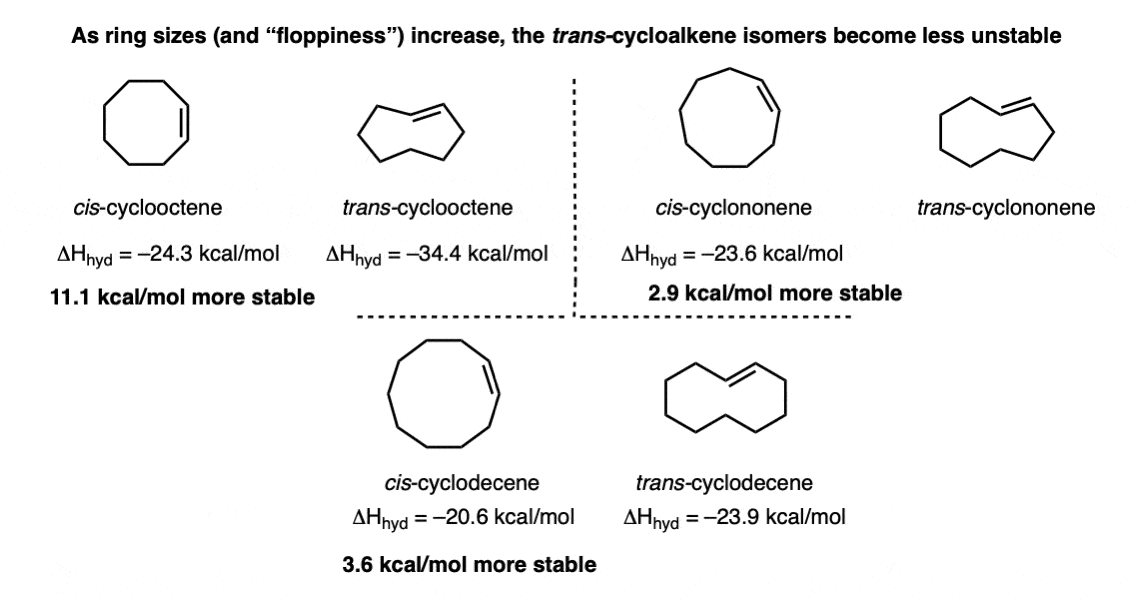
At ring sizes of 11 and 12 the trans-isomer actually becomes more stable (when allowed to equilibrate with acid) but recall that anything involving equilibrium is ultimately a measure of delta G, and delta G also includes an entropy term (S). It turns out that the main factor in the increased stability of 11- and 12- membered trans-cycloalkenes is their greater entropy. See this reference.
Quiz Yourself!
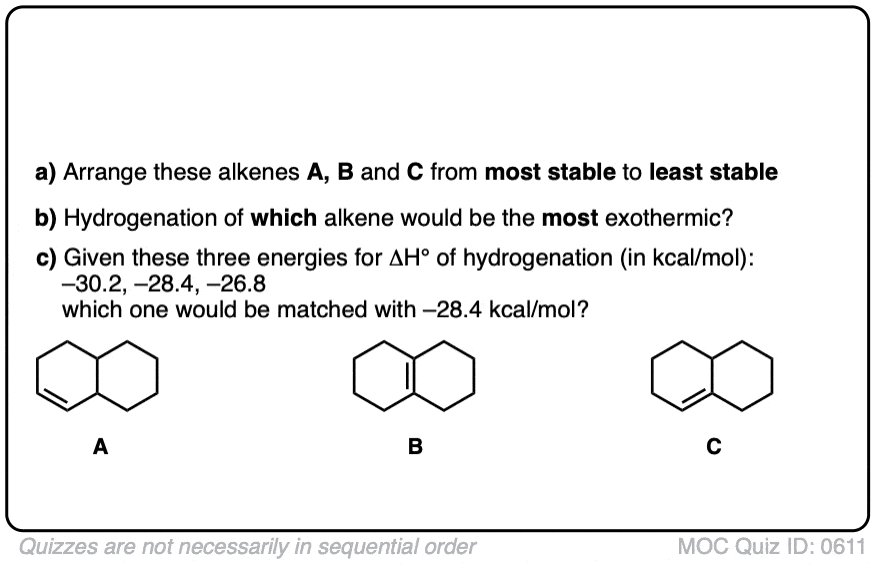 Click to Flip
Click to Flip
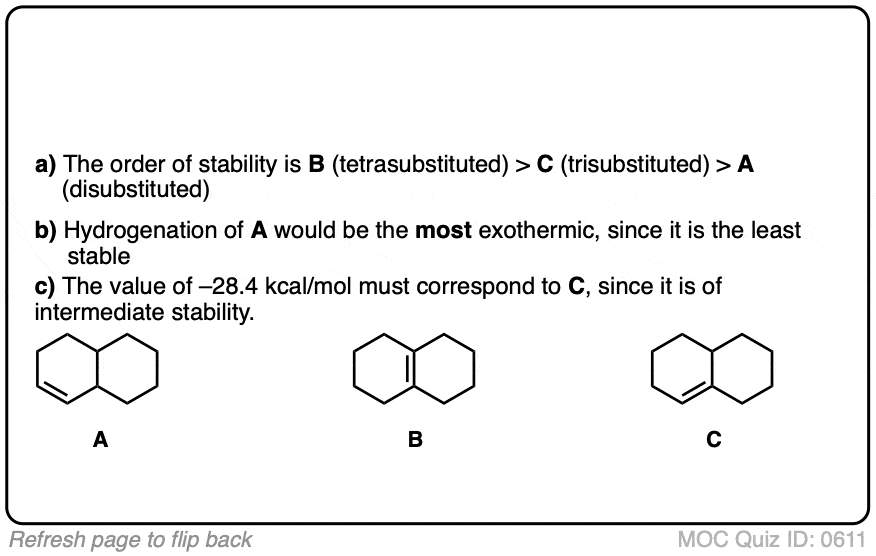
(Advanced) References and Further Reading
All heat of hydrogenation values cited here were obtained from the NIST Chemistry Web Book. Searching by CAS number never fails. Selected original references below.
- Heats of Organic Reactions. I. The Apparatus and the Heat of Hydrogenation of Ethylene
G. B. Kistiakowsky, H. Romeyn Jr., J. R. Ruhoff, Hilton A. Smith, and W. E. Vaughan
Journal of the American Chemical Society 1935 57 (1), 65-75
DOI: 10.1021/ja01304a019
Prof. Kistiakowsky’s first (of many) papers on the heat of hydrogenation of organic molecules, where he describes the apparatus required to obtain accurate heat of hydrogenation data in painstaking detail. The results stand up. - Heats of Organic Reactions. IV. Hydrogenation of Some Dienes and of Benzene
G. B. Kistiakowsky, John R. Ruhoff, Hilton A. Smith, and W. E. Vaughan
Journal of the American Chemical Society 1936 58 (1), 146-153
DOI: 10.1021/ja01292a043
Contains the heat of hydrogenation for 1,3 butadiene, benzene, and other unsaturated molecules, including allene (71.0 kcal/mol). - Heats of Hydrogenation. IV. Hydrogenation of Some cis- and trans-Cycloölefins1
Richard B. Turner and W. R. Meador
Journal of the American Chemical Society 1957 79 (15), 4133-4136
DOI: 10.1021/ja01572a042 - Heats of hydrogenation. IX. Cyclic acetylenes and some miscellaneous olefins
Richard B. Turner, A. D. Jarrett, P. Goebel, and Barbara J. Mallon
Journal of the American Chemical Society 1973 95 (3), 790-792
DOI: 10.1021/ja00784a025 - RELATIVE STABILITIES OF cis- AND trans-CYCLONONENE, CYCLODECENE, CYCLOUNDECENE AND CYCLODODECENE
Arthur C. Cope, Phylis T. Moore, and William R. Moore
Journal of the American Chemical Society 1959 81 (12), 3153-3153
DOI: 10.1021/ja01521a067
A.C. Cope reported that when cis– and trans– cycloundecene (11-membered) and cyclododecene (12-membered) are allowed to equilibrate (by heating with catalytic TsOH) the trans-double bond is favored at equilibrium (i.e. has lower Δ G)… even though trans-dodecene has a higher enthalpy (Δ H) than its cis-isomer. This is a helpful reminder that enthalpy (delta H) is just one part of the Gibbs equation (Δ G = Δ H – TΔ S), the trans-cycloalkenes have higher entropy (S) and this explains their greater stability.
00 General Chemistry Review
01 Bonding, Structure, and Resonance
- How Do We Know Methane (CH4) Is Tetrahedral?
- Hybrid Orbitals and Hybridization
- How To Determine Hybridization: A Shortcut
- Orbital Hybridization And Bond Strengths
- Sigma bonds come in six varieties: Pi bonds come in one
- A Key Skill: How to Calculate Formal Charge
- The Four Intermolecular Forces and How They Affect Boiling Points
- 3 Trends That Affect Boiling Points
- How To Use Electronegativity To Determine Electron Density (and why NOT to trust formal charge)
- Introduction to Resonance
- How To Use Curved Arrows To Interchange Resonance Forms
- Evaluating Resonance Forms (1) - The Rule of Least Charges
- How To Find The Best Resonance Structure By Applying Electronegativity
- Evaluating Resonance Structures With Negative Charges
- Evaluating Resonance Structures With Positive Charge
- Exploring Resonance: Pi-Donation
- Exploring Resonance: Pi-acceptors
- In Summary: Evaluating Resonance Structures
- Drawing Resonance Structures: 3 Common Mistakes To Avoid
- How to apply electronegativity and resonance to understand reactivity
- Bond Hybridization Practice
- Structure and Bonding Practice Quizzes
- Resonance Structures Practice
02 Acid Base Reactions
- Introduction to Acid-Base Reactions
- Acid Base Reactions In Organic Chemistry
- The Stronger The Acid, The Weaker The Conjugate Base
- Walkthrough of Acid-Base Reactions (3) - Acidity Trends
- Five Key Factors That Influence Acidity
- Acid-Base Reactions: Introducing Ka and pKa
- How to Use a pKa Table
- The pKa Table Is Your Friend
- A Handy Rule of Thumb for Acid-Base Reactions
- Acid Base Reactions Are Fast
- pKa Values Span 60 Orders Of Magnitude
- How Protonation and Deprotonation Affect Reactivity
- Acid Base Practice Problems
03 Alkanes and Nomenclature
- Meet the (Most Important) Functional Groups
- Condensed Formulas: Deciphering What the Brackets Mean
- Hidden Hydrogens, Hidden Lone Pairs, Hidden Counterions
- Don't Be Futyl, Learn The Butyls
- Primary, Secondary, Tertiary, Quaternary In Organic Chemistry
- Branching, and Its Affect On Melting and Boiling Points
- The Many, Many Ways of Drawing Butane
- Wedge And Dash Convention For Tetrahedral Carbon
- Common Mistakes in Organic Chemistry: Pentavalent Carbon
- Table of Functional Group Priorities for Nomenclature
- Summary Sheet - Alkane Nomenclature
- Organic Chemistry IUPAC Nomenclature Demystified With A Simple Puzzle Piece Approach
- Boiling Point Quizzes
- Organic Chemistry Nomenclature Quizzes
04 Conformations and Cycloalkanes
- Staggered vs Eclipsed Conformations of Ethane
- Conformational Isomers of Propane
- Newman Projection of Butane (and Gauche Conformation)
- Introduction to Cycloalkanes
- Geometric Isomers In Small Rings: Cis And Trans Cycloalkanes
- Calculation of Ring Strain In Cycloalkanes
- Cycloalkanes - Ring Strain In Cyclopropane And Cyclobutane
- Cyclohexane Conformations
- Cyclohexane Chair Conformation: An Aerial Tour
- How To Draw The Cyclohexane Chair Conformation
- The Cyclohexane Chair Flip
- The Cyclohexane Chair Flip - Energy Diagram
- Substituted Cyclohexanes - Axial vs Equatorial
- Ranking The Bulkiness Of Substituents On Cyclohexanes: "A-Values"
- Cyclohexane Chair Conformation Stability: Which One Is Lower Energy?
- Fused Rings - Cis-Decalin and Trans-Decalin
- Naming Bicyclic Compounds - Fused, Bridged, and Spiro
- Bredt's Rule (And Summary of Cycloalkanes)
- Newman Projection Practice
- Cycloalkanes Practice Problems
05 A Primer On Organic Reactions
- The Most Important Question To Ask When Learning a New Reaction
- Curved Arrows (for reactions)
- Nucleophiles and Electrophiles
- The Three Classes of Nucleophiles
- Nucleophilicity vs. Basicity
- What Makes A Good Nucleophile?
- What Makes A Good Leaving Group?
- 3 Factors That Stabilize Carbocations
- Equilibrium and Energy Relationships
- 7 Factors that stabilize negative charge in organic chemistry
- 7 Factors That Stabilize Positive Charge in Organic Chemistry
- What's a Transition State?
- Hammond's Postulate
- Learning Organic Chemistry Reactions: A Checklist (PDF)
- Introduction to Oxidative Cleavage Reactions
06 Free Radical Reactions
- Bond Dissociation Energies = Homolytic Cleavage
- Free Radical Reactions
- 3 Factors That Stabilize Free Radicals
- What Factors Destabilize Free Radicals?
- Bond Strengths And Radical Stability
- Free Radical Initiation: Why Is "Light" Or "Heat" Required?
- Initiation, Propagation, Termination
- Monochlorination Products Of Propane, Pentane, And Other Alkanes
- Selectivity In Free Radical Reactions
- Selectivity in Free Radical Reactions: Bromination vs. Chlorination
- Halogenation At Tiffany's
- Allylic Bromination
- Bonus Topic: Allylic Rearrangements
- In Summary: Free Radicals
- Synthesis (2) - Reactions of Alkanes
- Free Radicals Practice Quizzes
07 Stereochemistry and Chirality
- Types of Isomers: Constitutional Isomers, Stereoisomers, Enantiomers, and Diastereomers
- How To Draw The Enantiomer Of A Chiral Molecule
- How To Draw A Bond Rotation
- Introduction to Assigning (R) and (S): The Cahn-Ingold-Prelog Rules
- Assigning Cahn-Ingold-Prelog (CIP) Priorities (2) - The Method of Dots
- Enantiomers vs Diastereomers vs The Same? Two Methods For Solving Problems
- Assigning R/S To Newman Projections (And Converting Newman To Line Diagrams)
- How To Determine R and S Configurations On A Fischer Projection
- The Meso Trap
- Optical Rotation, Optical Activity, and Specific Rotation
- Optical Purity and Enantiomeric Excess
- What's a Racemic Mixture?
- Chiral Allenes And Chiral Axes
- Stereochemistry Practice Problems and Quizzes
08 Substitution Reactions
- Nucleophilic Substitution Reactions - Introduction
- Two Types of Nucleophilic Substitution Reactions
- The SN2 Mechanism
- Why the SN2 Reaction Is Powerful
- The SN1 Mechanism
- The Conjugate Acid Is A Better Leaving Group
- Comparing the SN1 and SN2 Reactions
- Polar Protic? Polar Aprotic? Nonpolar? All About Solvents
- Steric Hindrance is Like a Fat Goalie
- Common Blind Spot: Intramolecular Reactions
- Substitution Practice - SN1
- Substitution Practice - SN2
09 Elimination Reactions
- Elimination Reactions (1): Introduction And The Key Pattern
- Elimination Reactions (2): The Zaitsev Rule
- Elimination Reactions Are Favored By Heat
- Two Elimination Reaction Patterns
- The E1 Reaction
- The E2 Mechanism
- E1 vs E2: Comparing the E1 and E2 Reactions
- Antiperiplanar Relationships: The E2 Reaction and Cyclohexane Rings
- Bulky Bases in Elimination Reactions
- Comparing the E1 vs SN1 Reactions
- Elimination (E1) Reactions With Rearrangements
- E1cB - Elimination (Unimolecular) Conjugate Base
- Elimination (E1) Practice Problems And Solutions
- Elimination (E2) Practice Problems and Solutions
10 Rearrangements
11 SN1/SN2/E1/E2 Decision
- Identifying Where Substitution and Elimination Reactions Happen
- Deciding SN1/SN2/E1/E2 (1) - The Substrate
- Deciding SN1/SN2/E1/E2 (2) - The Nucleophile/Base
- SN1 vs E1 and SN2 vs E2 : The Temperature
- Deciding SN1/SN2/E1/E2 - The Solvent
- Wrapup: The Key Factors For Determining SN1/SN2/E1/E2
- Alkyl Halide Reaction Map And Summary
- SN1 SN2 E1 E2 Practice Problems
12 Alkene Reactions
- E and Z Notation For Alkenes (+ Cis/Trans)
- Alkene Stability
- Alkene Addition Reactions: "Regioselectivity" and "Stereoselectivity" (Syn/Anti)
- Stereoselective and Stereospecific Reactions
- Hydrohalogenation of Alkenes and Markovnikov's Rule
- Hydration of Alkenes With Aqueous Acid
- Rearrangements in Alkene Addition Reactions
- Halogenation of Alkenes and Halohydrin Formation
- Oxymercuration Demercuration of Alkenes
- Hydroboration Oxidation of Alkenes
- m-CPBA (meta-chloroperoxybenzoic acid)
- OsO4 (Osmium Tetroxide) for Dihydroxylation of Alkenes
- Palladium on Carbon (Pd/C) for Catalytic Hydrogenation of Alkenes
- Cyclopropanation of Alkenes
- A Fourth Alkene Addition Pattern - Free Radical Addition
- Alkene Reactions: Ozonolysis
- Summary: Three Key Families Of Alkene Reaction Mechanisms
- Synthesis (4) - Alkene Reaction Map, Including Alkyl Halide Reactions
- Alkene Reactions Practice Problems
13 Alkyne Reactions
- Acetylides from Alkynes, And Substitution Reactions of Acetylides
- Partial Reduction of Alkynes With Lindlar's Catalyst
- Partial Reduction of Alkynes With Na/NH3 To Obtain Trans Alkenes
- Alkyne Hydroboration With "R2BH"
- Hydration and Oxymercuration of Alkynes
- Hydrohalogenation of Alkynes
- Alkyne Halogenation: Bromination, Chlorination, and Iodination of Alkynes
- Alkyne Reactions - The "Concerted" Pathway
- Alkenes To Alkynes Via Halogenation And Elimination Reactions
- Alkynes Are A Blank Canvas
- Synthesis (5) - Reactions of Alkynes
- Alkyne Reactions Practice Problems With Answers
14 Alcohols, Epoxides and Ethers
- Alcohols - Nomenclature and Properties
- Alcohols Can Act As Acids Or Bases (And Why It Matters)
- Alcohols - Acidity and Basicity
- The Williamson Ether Synthesis
- Ethers From Alkenes, Tertiary Alkyl Halides and Alkoxymercuration
- Alcohols To Ethers via Acid Catalysis
- Cleavage Of Ethers With Acid
- Epoxides - The Outlier Of The Ether Family
- Opening of Epoxides With Acid
- Epoxide Ring Opening With Base
- Making Alkyl Halides From Alcohols
- Tosylates And Mesylates
- PBr3 and SOCl2
- Elimination Reactions of Alcohols
- Elimination of Alcohols To Alkenes With POCl3
- Alcohol Oxidation: "Strong" and "Weak" Oxidants
- Demystifying The Mechanisms of Alcohol Oxidations
- Protecting Groups For Alcohols
- Thiols And Thioethers
- Calculating the oxidation state of a carbon
- Oxidation and Reduction in Organic Chemistry
- Oxidation Ladders
- SOCl2 Mechanism For Alcohols To Alkyl Halides: SN2 versus SNi
- Alcohol Reactions Roadmap (PDF)
- Alcohol Reaction Practice Problems
- Epoxide Reaction Quizzes
- Oxidation and Reduction Practice Quizzes
15 Organometallics
- What's An Organometallic?
- Formation of Grignard and Organolithium Reagents
- Organometallics Are Strong Bases
- Reactions of Grignard Reagents
- Protecting Groups In Grignard Reactions
- Synthesis Problems Involving Grignard Reagents
- Grignard Reactions And Synthesis (2)
- Organocuprates (Gilman Reagents): How They're Made
- Gilman Reagents (Organocuprates): What They're Used For
- The Heck, Suzuki, and Olefin Metathesis Reactions (And Why They Don't Belong In Most Introductory Organic Chemistry Courses)
- Reaction Map: Reactions of Organometallics
- Grignard Practice Problems
16 Spectroscopy
- Degrees of Unsaturation (or IHD, Index of Hydrogen Deficiency)
- Conjugation And Color (+ How Bleach Works)
- Introduction To UV-Vis Spectroscopy
- UV-Vis Spectroscopy: Absorbance of Carbonyls
- UV-Vis Spectroscopy: Practice Questions
- Bond Vibrations, Infrared Spectroscopy, and the "Ball and Spring" Model
- Infrared Spectroscopy: A Quick Primer On Interpreting Spectra
- IR Spectroscopy: 4 Practice Problems
- 1H NMR: How Many Signals?
- Homotopic, Enantiotopic, Diastereotopic
- Diastereotopic Protons in 1H NMR Spectroscopy: Examples
- 13-C NMR - How Many Signals
- Liquid Gold: Pheromones In Doe Urine
- Natural Product Isolation (1) - Extraction
- Natural Product Isolation (2) - Purification Techniques, An Overview
- Structure Determination Case Study: Deer Tarsal Gland Pheromone
17 Dienes and MO Theory
- What To Expect In Organic Chemistry 2
- Are these molecules conjugated?
- Conjugation And Resonance In Organic Chemistry
- Bonding And Antibonding Pi Orbitals
- Molecular Orbitals of The Allyl Cation, Allyl Radical, and Allyl Anion
- Pi Molecular Orbitals of Butadiene
- Reactions of Dienes: 1,2 and 1,4 Addition
- Thermodynamic and Kinetic Products
- More On 1,2 and 1,4 Additions To Dienes
- s-cis and s-trans
- The Diels-Alder Reaction
- Cyclic Dienes and Dienophiles in the Diels-Alder Reaction
- Stereochemistry of the Diels-Alder Reaction
- Exo vs Endo Products In The Diels Alder: How To Tell Them Apart
- HOMO and LUMO In the Diels Alder Reaction
- Why Are Endo vs Exo Products Favored in the Diels-Alder Reaction?
- Diels-Alder Reaction: Kinetic and Thermodynamic Control
- The Retro Diels-Alder Reaction
- The Intramolecular Diels Alder Reaction
- Regiochemistry In The Diels-Alder Reaction
- The Cope and Claisen Rearrangements
- Electrocyclic Reactions
- Electrocyclic Ring Opening And Closure (2) - Six (or Eight) Pi Electrons
- Diels Alder Practice Problems
- Molecular Orbital Theory Practice
18 Aromaticity
- Introduction To Aromaticity
- Rules For Aromaticity
- Huckel's Rule: What Does 4n+2 Mean?
- Aromatic, Non-Aromatic, or Antiaromatic? Some Practice Problems
- Antiaromatic Compounds and Antiaromaticity
- The Pi Molecular Orbitals of Benzene
- The Pi Molecular Orbitals of Cyclobutadiene
- Frost Circles
- Aromaticity Practice Quizzes
19 Reactions of Aromatic Molecules
- Electrophilic Aromatic Substitution: Introduction
- Activating and Deactivating Groups In Electrophilic Aromatic Substitution
- Electrophilic Aromatic Substitution - The Mechanism
- Ortho-, Para- and Meta- Directors in Electrophilic Aromatic Substitution
- Understanding Ortho, Para, and Meta Directors
- Why are halogens ortho- para- directors?
- Disubstituted Benzenes: The Strongest Electron-Donor "Wins"
- Electrophilic Aromatic Substitutions (1) - Halogenation of Benzene
- Electrophilic Aromatic Substitutions (2) - Nitration and Sulfonation
- EAS Reactions (3) - Friedel-Crafts Acylation and Friedel-Crafts Alkylation
- Intramolecular Friedel-Crafts Reactions
- Nucleophilic Aromatic Substitution (NAS)
- Nucleophilic Aromatic Substitution (2) - The Benzyne Mechanism
- Reactions on the "Benzylic" Carbon: Bromination And Oxidation
- The Wolff-Kishner, Clemmensen, And Other Carbonyl Reductions
- More Reactions on the Aromatic Sidechain: Reduction of Nitro Groups and the Baeyer Villiger
- Aromatic Synthesis (1) - "Order Of Operations"
- Synthesis of Benzene Derivatives (2) - Polarity Reversal
- Aromatic Synthesis (3) - Sulfonyl Blocking Groups
- Birch Reduction
- Synthesis (7): Reaction Map of Benzene and Related Aromatic Compounds
- Aromatic Reactions and Synthesis Practice
- Electrophilic Aromatic Substitution Practice Problems
20 Aldehydes and Ketones
- What's The Alpha Carbon In Carbonyl Compounds?
- Nucleophilic Addition To Carbonyls
- Aldehydes and Ketones: 14 Reactions With The Same Mechanism
- Sodium Borohydride (NaBH4) Reduction of Aldehydes and Ketones
- Grignard Reagents For Addition To Aldehydes and Ketones
- Wittig Reaction
- Hydrates, Hemiacetals, and Acetals
- Imines - Properties, Formation, Reactions, and Mechanisms
- All About Enamines
- Breaking Down Carbonyl Reaction Mechanisms: Reactions of Anionic Nucleophiles (Part 2)
- Aldehydes Ketones Reaction Practice
21 Carboxylic Acid Derivatives
- Nucleophilic Acyl Substitution (With Negatively Charged Nucleophiles)
- Addition-Elimination Mechanisms With Neutral Nucleophiles (Including Acid Catalysis)
- Basic Hydrolysis of Esters - Saponification
- Transesterification
- Proton Transfer
- Fischer Esterification - Carboxylic Acid to Ester Under Acidic Conditions
- Lithium Aluminum Hydride (LiAlH4) For Reduction of Carboxylic Acid Derivatives
- LiAlH[Ot-Bu]3 For The Reduction of Acid Halides To Aldehydes
- Di-isobutyl Aluminum Hydride (DIBAL) For The Partial Reduction of Esters and Nitriles
- Amide Hydrolysis
- Thionyl Chloride (SOCl2)
- Diazomethane (CH2N2)
- Carbonyl Chemistry: Learn Six Mechanisms For the Price Of One
- Making Music With Mechanisms (PADPED)
- Carboxylic Acid Derivatives Practice Questions
22 Enols and Enolates
- Keto-Enol Tautomerism
- Enolates - Formation, Stability, and Simple Reactions
- Kinetic Versus Thermodynamic Enolates
- Aldol Addition and Condensation Reactions
- Reactions of Enols - Acid-Catalyzed Aldol, Halogenation, and Mannich Reactions
- Claisen Condensation and Dieckmann Condensation
- Decarboxylation
- The Malonic Ester and Acetoacetic Ester Synthesis
- The Michael Addition Reaction and Conjugate Addition
- The Robinson Annulation
- Haloform Reaction
- The Hell–Volhard–Zelinsky Reaction
- Enols and Enolates Practice Quizzes
23 Amines
- The Amide Functional Group: Properties, Synthesis, and Nomenclature
- Basicity of Amines And pKaH
- 5 Key Basicity Trends of Amines
- The Mesomeric Effect And Aromatic Amines
- Nucleophilicity of Amines
- Alkylation of Amines (Sucks!)
- Reductive Amination
- The Gabriel Synthesis
- Some Reactions of Azides
- The Hofmann Elimination
- The Hofmann and Curtius Rearrangements
- The Cope Elimination
- Protecting Groups for Amines - Carbamates
- The Strecker Synthesis of Amino Acids
- Introduction to Peptide Synthesis
- Reactions of Diazonium Salts: Sandmeyer and Related Reactions
- Amine Practice Questions
24 Carbohydrates
- D and L Notation For Sugars
- Pyranoses and Furanoses: Ring-Chain Tautomerism In Sugars
- What is Mutarotation?
- Reducing Sugars
- The Big Damn Post Of Carbohydrate-Related Chemistry Definitions
- The Haworth Projection
- Converting a Fischer Projection To A Haworth (And Vice Versa)
- Reactions of Sugars: Glycosylation and Protection
- The Ruff Degradation and Kiliani-Fischer Synthesis
- Isoelectric Points of Amino Acids (and How To Calculate Them)
- Carbohydrates Practice
- Amino Acid Quizzes
25 Fun and Miscellaneous
- A Gallery of Some Interesting Molecules From Nature
- Screw Organic Chemistry, I'm Just Going To Write About Cats
- On Cats, Part 1: Conformations and Configurations
- On Cats, Part 2: Cat Line Diagrams
- On Cats, Part 4: Enantiocats
- On Cats, Part 6: Stereocenters
- Organic Chemistry Is Shit
- The Organic Chemistry Behind "The Pill"
- Maybe they should call them, "Formal Wins" ?
- Why Do Organic Chemists Use Kilocalories?
- The Principle of Least Effort
- Organic Chemistry GIFS - Resonance Forms
- Reproducibility In Organic Chemistry
- What Holds The Nucleus Together?
- How Reactions Are Like Music
- Organic Chemistry and the New MCAT
26 Organic Chemistry Tips and Tricks
- Common Mistakes: Formal Charges Can Mislead
- Partial Charges Give Clues About Electron Flow
- Draw The Ugly Version First
- Organic Chemistry Study Tips: Learn the Trends
- The 8 Types of Arrows In Organic Chemistry, Explained
- Top 10 Skills To Master Before An Organic Chemistry 2 Final
- Common Mistakes with Carbonyls: Carboxylic Acids... Are Acids!
- Planning Organic Synthesis With "Reaction Maps"
- Alkene Addition Pattern #1: The "Carbocation Pathway"
- Alkene Addition Pattern #2: The "Three-Membered Ring" Pathway
- Alkene Addition Pattern #3: The "Concerted" Pathway
- Number Your Carbons!
- The 4 Major Classes of Reactions in Org 1
- How (and why) electrons flow
- Grossman's Rule
- Three Exam Tips
- A 3-Step Method For Thinking Through Synthesis Problems
- Putting It Together
- Putting Diels-Alder Products in Perspective
- The Ups and Downs of Cyclohexanes
- The Most Annoying Exceptions in Org 1 (Part 1)
- The Most Annoying Exceptions in Org 1 (Part 2)
- The Marriage May Be Bad, But the Divorce Still Costs Money
- 9 Nomenclature Conventions To Know
- Nucleophile attacks Electrophile
27 Case Studies of Successful O-Chem Students
- Success Stories: How Corina Got The The "Hard" Professor - And Got An A+ Anyway
- How Helena Aced Organic Chemistry
- From a "Drop" To B+ in Org 2 – How A Hard Working Student Turned It Around
- How Serge Aced Organic Chemistry
- Success Stories: How Zach Aced Organic Chemistry 1
- Success Stories: How Kari Went From C– to B+
- How Esther Bounced Back From a "C" To Get A's In Organic Chemistry 1 And 2
- How Tyrell Got The Highest Grade In Her Organic Chemistry Course
- This Is Why Students Use Flashcards
- Success Stories: How Stu Aced Organic Chemistry
- How John Pulled Up His Organic Chemistry Exam Grades
- Success Stories: How Nathan Aced Organic Chemistry (Without It Taking Over His Life)
- How Chris Aced Org 1 and Org 2
- Interview: How Jay Got an A+ In Organic Chemistry
- How to Do Well in Organic Chemistry: One Student's Advice
- "America's Top TA" Shares His Secrets For Teaching O-Chem
- "Organic Chemistry Is Like..." - A Few Metaphors
- How To Do Well In Organic Chemistry: Advice From A Tutor
- Guest post: "I went from being afraid of tests to actually looking forward to them".
Im 4th year student of pharmacy university and organic chemistry is brutal at my uni. we dont have orgo 1 ,2 , we have just one :D that covers everything ahaha meaning we have 5hr of lectures per week and that means each week u must study 3-4 lectures +2 to be always ahead with the fact that we write test each week before lab . if u fail ur done . Today we had alkenes and prof mentioned kinda really useful info. If u have cation of tertiary carbon . Imagien other substituents pushing on him thus stabilizating . like when you are in metro and its crowded, people are pushing on them selves an when it stops fast. you cant fall because someone is holding you , when u remove one person around you. still 3 people can ,,stabilize , you when it stops. but if its just one ? naaah u go flying .
WHY TRANS ISOMER HAS A HIGHER ENTROPY? SIR
Why 1,1 di substituted alkenes are more Stable than 1,2 trans substituted alkene
Then why in epoxidation reaction, the more substituted alkene is more reactive?
Yes – it seems somewhat contradictory that the more substituted alkene would be the most reactive in reactions such as epoxidation and also in addition of HX to alkenes.
In reactions with electrophiles (like mCPBA) the alkene is the nucleophile. Generally, the greater the number of substituents attached to the alkene, the more nucleophilic it is (electron-rich). The transition state for an epoxidation reaction has several electron-deficient carbon atoms. Greater substitution on the alkene by additional alkyl groups helps to donate electron density to the electron poor carbon atoms, lowering the energy of the transition state and leading to a faster reaction.
excuse me, in the molecular orbital diagram why does it say pi (C-H) + pi* and not sigma (C-H) + pi* for the molecular orbitals, when it’s a C-H sigma bond donating the electron pair? Am I missing something again?
Hey, it is stated that “the heat of hydrogenation is quite consistent for a series of linear, (((non-branched))) monosubstituted alkenes.” What if it’s branched? Let’s say compare the stability between 2-methyl-2-butene and 2,2-dimethyl-3-pentene. Do we have to still prioritize the number of substituents as the most consideration?
IUPAC naming does not permit 2,2-dimethyl-3-pentene. It could be 2,2-dimethyl-2-pentene (which is trisubstituted) or 4,4-dimethyl-2-pentene (which is disubstituted, could be cis or trans).
Offhand, without checking the data, I would confidently say that the trisubstituted alkene is more stable by about 1 kcal/mol over the trans disubstituted.
The data presented in this post is all from the same paper, a study of the enthalpies of hydrogenation of the hexenes.
https://www.sciencedirect.com/science/article/abs/pii/0021961487900589 .
The heat of hydrogenation of the geminal and the trans are comparable to the first decimal place in this case.
Hi, for the appendix 1, does this mean that the sigma(C-H) orbitals can donate e- density to both pi and pi* orbitals in C=C for stabilization? And for the donation to pi* antibonding orbital, may I ask will this weaken the C=C pi bond (since I heard that donation to antibonding orbitals weaken the bonding orbitals)? thanks a lot :)
Hey! minor correction – I looked up the data you qouted and geminal double bonds are about the same stability as a cis bond, not a trans bond. NIST gives -117.8 for geminal hydrogenation of 2-methylpropene, -118.5 for the trans version and -114.5 for cis version.
Darn it. Thank you for bringing that to my attention, I’ll have to look into fixing that.